|
Notes for an Unknown Reunion 2004
—black tie
—wailing sax
—keynote speaker: Salinger? Pynchon?
—large mushroom decor: suspended fr/ceiling w/bungee cords (clashes
w/black tie?)
—top call
—supergroup: foreigner? styx?
—limo: stretch humvee, yellow
—good selection of juices and smoothies

&Now
Notre Dame University
April 5-6, 2004
William: Compared to the Holocaust Conference going on up in Massachusetts
this weekend, I think &Now was an especially fun place to be. The
presenters were freaks for the most part, freaks and Lydia Davis, from
the fringes of word art. Those who write and have other people publish
books of stories or poems were probably in the minority. There was
abundant electronica, collaborative text-collage performance, multimedia
performance
fiction, text-image-sound, and even a critic.
Compared to AWP in Chicago last month (4600 in attendance), the frightening
barren gothic oppressively mirthless tornadoproof Cambridge WWII Air
Raid ambiance of Notre Dame University and small number of people in
attendance ensured an opportunity to feel satisfied one had connected
with a good number of other attendees without the distractions of being
in an interesting city. FC2 was the largest and most mainstream publisher
represented at the book tables. But Xexoxial Endarchy had the largest
table. Except for the spooky Crucifix-encrusted hotel rooms with twin
twin
beds (did
we have
to
show a marriage license
to get a king-sized?) across the street from the happenings, the vibe
was quite good.
Compared to E-Fest at Brown this February, the electronic work was presented
in a fitting context: experimental literature, the focus being words
rather than computers. Gone was the flavor of the dichotomy, print against
electronic, "The End of Books." Instead we see fires of enthusiasm
burning across the country, their wires leading back to the ELO, Coover,
Los Angeles and Chicago. Experimental literature is also a better context
to present electronic work than professional literature (as with the
generally underattended freak show Web Fair at AWP). The Unknown was
booed off the stage but we were totally drunk.
Scott: Don't believe the hype. The Unknown were stone cold sober,
and warmly received by the six or seven folks attending our presentation
(McCaffery's strip-tease with House of Leaves was pulling
from our draw, otherwise there would have been multitudes). Aside from
that
I totally agree with William. There was an exquisite vibe at the &Now
conference and several exquisite corpses as well. It's the first time
in a long time that I've been to a conference at which the writers
outnumbered the critics.
 In
terms of a way to introduce electronic literature to literary culture, &Now
was a near-ideal environment. Almost everyone at &Now was doing
something well outside the mainstream: subversive fiction, fiction
that involved combinatory and/or balloter techniques, fiction that
was concerned with materiality in a way that most fiction is not: aggressively
weird word-works. Nearly everyone there was writing in a way that is
not taught in writing workshops. Perhaps because of that, there seemed
to be an openness to new forms. Hypertext is just one of many strange
things that writers can do with words to interesting effect. &Now
was a gathering of writers who work in forms outside of the mainstream,
and there was a remarkable spirit of simple curiosity. I only missed
one morning session and wish that I had been able to attend all of
the sessions. A bunch of writers were sharing their strange work with
other writers. You felt compelled to attend, and listen, and watch.
Although the principle medium was print, there were a variety of stories
told in fragments (Lydia Davis' exceptional short short stories among
them), stories that involved combinatory strategies, stories that were
overwritings of other stories, stories that made use of aleatory material,
stories that utilized multiple media (such as books published with
audio CDs) or Debra DiBlasi's multimedia performance, stories that
were authored by multiple collaborators, stories that used images,
drawings, collages and photographs as narrative material. One refreshing
aspect of the conference was that there were no sharp divisions drawn
between electronic and non-electronic work. Stephanie Strickland's
e-poem "V:Inverse" appeared in the same session as work presented by
two experimental novelists. In
terms of a way to introduce electronic literature to literary culture, &Now
was a near-ideal environment. Almost everyone at &Now was doing
something well outside the mainstream: subversive fiction, fiction
that involved combinatory and/or balloter techniques, fiction that
was concerned with materiality in a way that most fiction is not: aggressively
weird word-works. Nearly everyone there was writing in a way that is
not taught in writing workshops. Perhaps because of that, there seemed
to be an openness to new forms. Hypertext is just one of many strange
things that writers can do with words to interesting effect. &Now
was a gathering of writers who work in forms outside of the mainstream,
and there was a remarkable spirit of simple curiosity. I only missed
one morning session and wish that I had been able to attend all of
the sessions. A bunch of writers were sharing their strange work with
other writers. You felt compelled to attend, and listen, and watch.
Although the principle medium was print, there were a variety of stories
told in fragments (Lydia Davis' exceptional short short stories among
them), stories that involved combinatory strategies, stories that were
overwritings of other stories, stories that made use of aleatory material,
stories that utilized multiple media (such as books published with
audio CDs) or Debra DiBlasi's multimedia performance, stories that
were authored by multiple collaborators, stories that used images,
drawings, collages and photographs as narrative material. One refreshing
aspect of the conference was that there were no sharp divisions drawn
between electronic and non-electronic work. Stephanie Strickland's
e-poem "V:Inverse" appeared in the same session as work presented by
two experimental novelists.
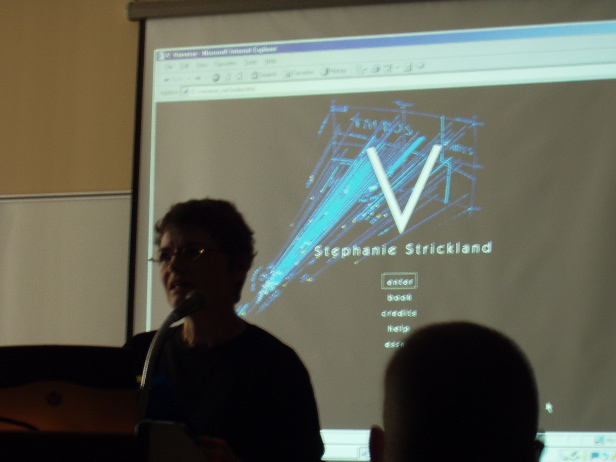 As
William noted, one thing that is often lacking at gatherings of electronic
literati is what, for lack of a better term, I would call a
literary context. While ELO, DAC, trAce, Hypertext, etc. conferences
are always informative and often exhilarating and it's beneficial for
those of working in the field to get together on these occasions to
share ideas and renew our sense of community, sometimes there's a sense
of disconnect from writing and the arts made for other media. Likewise,
when e-writing shows its face at professional gatherings such as the
MLA and AWP, it often seems marginalized, something only begrudgingly
included in the sub-basement of literature. &Now was a refreshing
turn from that. Steve Tomasula did a great job of bringing writers
working on the margins together in South Bend. As
William noted, one thing that is often lacking at gatherings of electronic
literati is what, for lack of a better term, I would call a
literary context. While ELO, DAC, trAce, Hypertext, etc. conferences
are always informative and often exhilarating and it's beneficial for
those of working in the field to get together on these occasions to
share ideas and renew our sense of community, sometimes there's a sense
of disconnect from writing and the arts made for other media. Likewise,
when e-writing shows its face at professional gatherings such as the
MLA and AWP, it often seems marginalized, something only begrudgingly
included in the sub-basement of literature. &Now was a refreshing
turn from that. Steve Tomasula did a great job of bringing writers
working on the margins together in South Bend.

The conference also got me thinking that one thing the ELO should
do is help people like Steve who are interested in putting together
such
festivals to mobilize an e-writing contingent. While folks like Miekal
And, Stephanie Strickland, Rob Wittig, Mark Marino and the Unknown
were present at &Now, Steve mentioned to me that he was hoping
a few more electronic writers could show up. And it would be interesting
to see other combinations: a festival of electronic writers and avant
garde painters, a festival of electronic writers and designers, a festival
of electronic writers and performance artists. While the combinations
of electronic writers, theorists and critics; electronic writers, librarians,
and archivists; electronic writers and digital artists; and electronic
writers and programmers that we see at the dominant conferences in
the field are fruitful ones, it would also be refreshing to participate
in more gatherings that are focused more essentially on sharing interesting
work made for multiple media.
I think that the e-writers in attendance learned as much about making
interesting work from Lydia Davis' generous asides about her writing
process and her anxieties about creating as we do from any critical
analysis of hypertext structures.
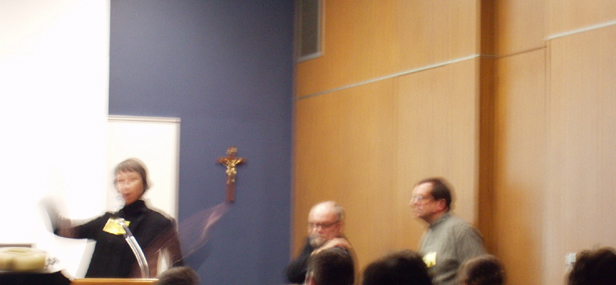
Michael Joyce, the author of the legendary hypertext Afternoon,
a story, was one of the writers in attendance. Joyce, having
semipublicly retired
from electronic writing, is now working with artist Alexandra Grant
on her paintings and wire sculptures which utilize texts by Joyce
to create word-images and word-sculptures that transfer some of
the ideas
and structures of hypertext into a physical space. Although Joyce
isn't writing for the electronic media anymore, in a way he is
still writing
hypertext. Like many of us, Joyce is using some of the ideas from
his electronic work in a different medium. I think that Joyce's
transition is emblematic of a dialogue that we all should be engaged
in. What
can game-makers learn from sculptors? What can e-poets learn from
architects?
Ultimately, it matters less that we are electronic writers or digital
artists than it does that we are writers and artists, experimenting
in forms old and
new. Perhaps the division between electronic writing and print writing
will eventually break down and we will simply create and study 21st
Century writing, which manifests
itself in different forms in multiple media.

Here's something from robwit.net to
add to the kitty.

Rob: I agree with Wm. and Scott. Kudos to Steve Tomasula for a
great gathering! It lived up to its billing—"festival" indeed!
DESIGNERS AND WRITERS
Stephanie Strickland, during a discussion of teaching-for-money and art-making-for-soul
and design-world-compared-with-literary-world (over gigantic bloody-rare
steaks), said it best: "Designers know how to play, and they get
the conceptual stuff right away." There it is. The two points that
keep me traveling back and forth between the literary and design worlds
and matchmaking collaborations. Many solid experiments with such commingling
were on display at &Now.
http://www.stephaniestrickland.com
PERSONAL FIRST IMPRESSIONS
It's been a while since I've been in a literary setting (and this one was much
more fun and lively than the usual). I tried to use that freshness to make some
simple observations.
1_Not many of us are interested in this kind of writing.
2_Across the board, across age, medium and strategy, there is a pretty consistent
writing style here—a flat, pseudo-scientific or pseudo-historical prose with
few rhythmic changes to break the smooth surface. Like a style that has forgotten
that it began as a parody. Little variety in sentence structure. A specialized
Literary Vocabulary used only in work like this. The flat style feels to me like
it's used to distance writer and reader from emotion, as though emotion can only
be handled through a heavy fire-suit with yard-long tongs. I was going: I want
Speedos and bikinis! Hugs and kisses! I want confetti! Extravagance! Baroque
style! Generosity! Jokes and stunts! Color and drumming! Silliness-and-seriousness,
rather than seriousness-and-seriousness.
3_As people, the writers seem like a group of courageous shy people.
4_The Norwegian student who traveled all the way from Oslo for the festival was
quite surprised that nearly all the writers earned their livings by teaching
at the university level.
BAJA
David Matlin (whose reading I missed, unfortunately) spoke eloquently over breakfast
of the cultural energy of the Northern Baja California region of Mexico, particularly
the cities of Tijuana and Mexicali. Adds to the list of clues that makes SW California
/ NW Baja sound very happening these days.
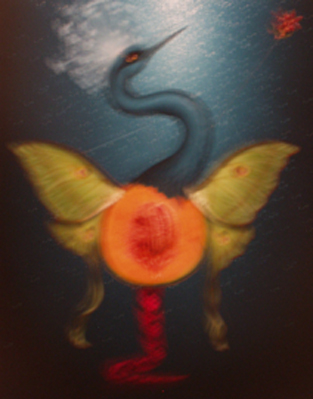 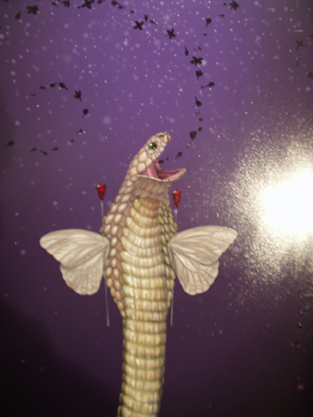
DELIGHTFUL SURPRISE
A wonderful discovery of the festival for me was the painting of Maria Tomasula,
which some of us got to see during one of the two parties held on festival nights
at Casa Tomasula. Precise, eerie, smart, haunting, the panels occasioned lively
conversation and a chorus of oohs and ahhs. She has a show coming up soon.
http://www.forumgallery.com/2003/e_tomasula.htm
MARTONE-ISMS
Author Michael Martone read his hip-pocket definition of Postmodernism = the
shocking of the avant garde by the middle class (e.g. Jerry Springer, et al.)
Nice quip. It struck me overall at the conference that there was a danger of
believing that one's education in historic avant gardes somehow confers automatic
avant garde status on one's own work. For all the quirky craftsmanship and dedicated
pursuit of weirdness in the &Now Festival writing, this particular avant
garde still seemed to me to be pretty much in the caboose of culture. Martone
also has developed a nice image of universities as "cold storage" for
cultural practices (like the cold storage for nearly-eliminated diseases the
government doesn't quite want to get rid of yet). Reminded me of my old vision
of Grand Opera performances, and certain poetry readings as "historical
reenactments" of a once-living art form (a la reenactments of Civil War
Battles). http://www.gutcult.com/litjourn2/html/MM1.html
BIG PICTURE
Eduardo Kac's short, but punchy, presentation—a speculative list of possible
bio-literary projects like texts written in bee-dance language for an audience
of bees, or molecules created to spell words, or texts translated into DNA sequences
and then read back generations later—was refreshing.
http://www.ekac.org
After a couple of decades of computing science being the pet scientific discipline
of progressive writers—what one might call the Space Age—biology is now
the pet scientific discipline of progressive writers; in particular 1) genomics,
and 2) the neuroscience of emotion; Literature as an elaborate method for triggering
the production of seratonin and dopamine.
What this may mean in practical terms is that presentations of computer-based
or computer-assisted literature may no longer begin with descriptions of the
technology, but will launch right into performance, mood and story. The computer
itself is moving into the background as a tool or substrate.
CGP
What makes Larry McCaffery different from so many critics is his ATTITUDE of
CGP—Curiosity, Generosity, Playfulness. It's refreshing.
William: One of the things I most admire about Larry as a critic
is that, increasingly, he is less interested in literature than in the desert.
And he's right: the desert is more interesting. He took us driving in Borrego,
frightened us a bit, and at the &Now conference he always had something
good to drop into the Q and A. He knew Lydia from San Diego circa 1980 when
they would play Boggle together on the edge of things. He knows everybody.
He's Vollman's chauffeur and Federman's caddy/archivist. Starting as a science
fiction or Robert Coover scholar, he drifted along every cool fringe. His specialty
may be his interviews, available in several volumes as well as many periodicals.
His influence on FC2 led to the imprint Black Ice books, with its rigorous
list, dedicated to a high weirdness-to-consumer-cost ratio. Among their titles
is the malignant classic Hogg, by Samuel Delany. Larry has pushed
criticism in directions that are fearsome, experimental, and strikingly nonacademic,
including some wonderful essays on rock and roll. See his collage-essay in
the Review of Contemporary Fiction Barthelme number. Or see the recent
issue featuring Japanese fiction, edited by Larry. In fact, Larry's been all
over
the Review for quite awhile, and American Book Review, and the Journal
of Experimental Fiction (Federman issue). See Storming the Reality
Studio, the cyberpunk anthology,
for a stinging taste of the 1980s. That was my first McCaffery. See the avant-criticism
McCaffery Archive at spinelessbooks.com/mccaffery,
updated when Larry feels nostalgic. But usually he's looking into the future.
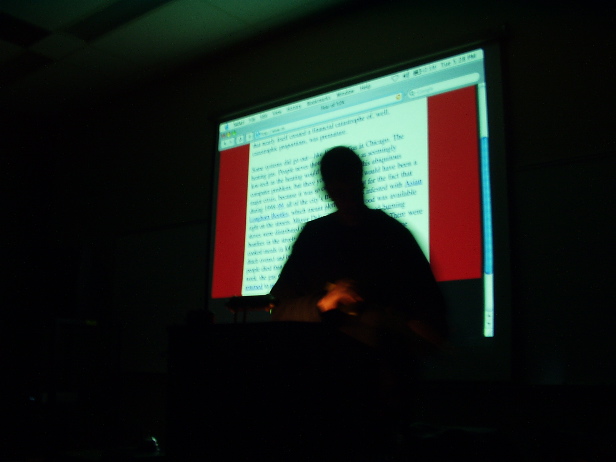
|

